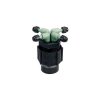Common mistakes to avoid
The following list is designed to help you familiarize yourself with some of the most common mistakes made during design and/or installation of a drip irrigation system.
Not enough emitters:
One of the most common mistakes made is not using enough drip emitters. You need to ensure that the plant you are watering will have its entire root system watered. Large plants and/or pots may require many drip emitters or dripline. Try to avoid a situtaion where a plant is relying on only 1 emitter for all water. If the emitter clogs, the plant may die. Ideally, all plants would be able to draw water from at least two sources to protect against cloged emitters. This can be accomplished by using two or more emitters per plant or sharing emitters between plants. The exception to this rule would be small pots (12" or under). With small pots, usually 1 emitter is all that is practical but the clogging risk remains.
Bad placement:
Another mistake is to place the drip emitters too close together or too far apart. Drip emitters should be spaced evenly around the plant and kept at least six (6) inches from the base of the plant. This will help to avoid any fungal infections on the main plant stem. If your plant is on a hill, place the majority of emitters above the plant.
Poor filtration:
Use the correct filter for your drip system. Select the proper screen mesh for the water quality and type of emitters used. We recommend using a filter with a screen mesh of at least 155. Never operate a drip system without proper filtration, doing so is just asking for problems.
Incorrect pressure:
For a drip irrigation system to function properly it must be operated at the correct pressure. (PSI) If you try to put too many emitters on a line your pressure will fall below the operating minimum pressure and your system will fail. If you use an incorrect pressure regulator or none at all, your system will have too much pressure and not operate correctly.
Improper zoning:
"Zoning" refers to grouping large drip systems into "zones" of commonality. Usually, zones are grouped by plant type. Trees are separated from shrubs. Dry climate plants are separated from humid climate plants etc. If you have various soil types you can separate them into zones also. The main thing to remember is, after you get your system running, will you be able to water each plant according to its needs? If you put a large tree on the same line as a small shrub, one of them is probably going to be too dry or too wet.
Wrong watering schedule:
The key to this is, "trial-and-error". Don't just install your new drip system and walk away, trusting that your plants will make it. A drip system is not a "hands off" method of watering. A drip system is a "less hands on than if you had to stand there all summer with a hose" method of watering. You still need to check on the system periodically to ensure that it is working. Adjust the run times for the season. If you have a few days coming up that are 105 degrees, you may want to run the system a little longer. Likewise, if it is unusually cold for the season you may want to shorten the run times to keep from drowning your plants. The key is to watch your plants and pay attention to their needs. But most of all I'd call the manufacturer of Yer system. Or try callin a local hydro store and ask em. Some other links>>
http://www.irrigationtutorials.com/drip-emitter.htm
http://www.irrigationtutorials.com/faq/psi-loss-calculator.htm << pressure loss calculator.









